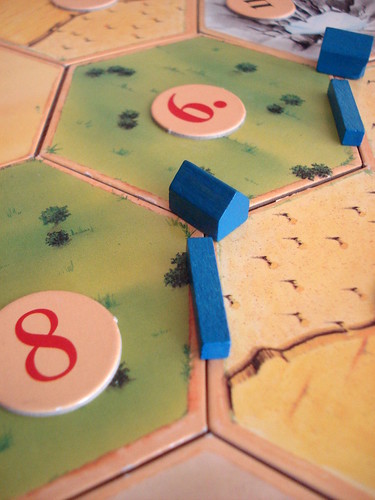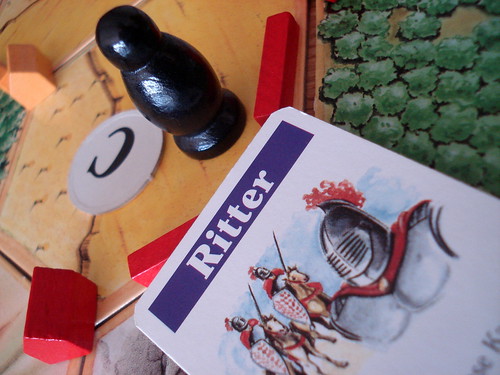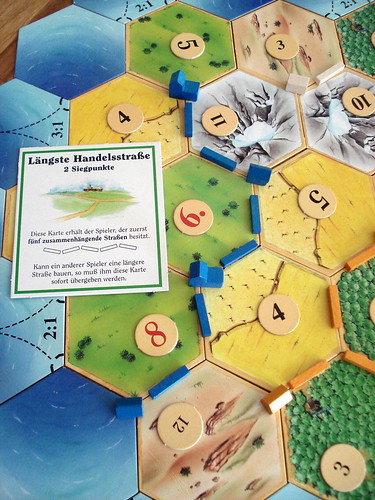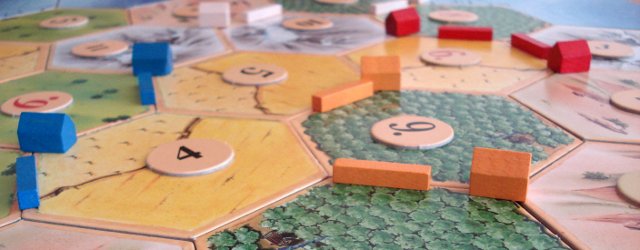The Settlers of Catan, invented by Klaus Teuber and first published by Kosmos in 1995, shows all the qualities that are characteristic for euro style games: games are short, lasting from 60 to 90 minutes, turns are short as well and keep all players involved, eliminating downtime between turns, the game is easy to learn and has no violent interaction between players, especially no player elimination. I’ll assume that not everybody knows how The Settlers of Catan is played in detail, despite it’s popularity.

The setting of the game is the island of Catan, which you are unsurprisingly setting out to settle. Catan is a hexagonal island made of 19 smaller hexagons, each belonging to one type of landscape: hills, pastures, mountains, fields, forest and a desert. These landscape produce resources: bricks, sheep, ore. grain , lumber and absolutely nothing at all. Each hex except the desert also has a chip with a number from two to twelve on it to determine when it produces that resource. Not all hexes are created equal; where resources are produced is determined by the roll of two dice, and as we all know – at least we should, because that kind of knowledge is very helpful when playing games with dice – that means twos and twelves are less common than, for example, sixes, putting very different values on the island’s real estate.
Players start the game by placing two settlements on the board. Settlements and cities are built on the tiles’ corners, giving a settlement in the centre of the island access to three tiles to harvest resources from. To sweeten the less valuable spots on the coast, a number of harbors is located around the island; they give their owner more favourable trading conditions. After those settlements are well and truly founded, the real game begins.
Each players turn starts by rolling the dice to collect resources: all hexes with that number produce and all players with settlements around such a hex collect. Except if you roll a seven, which – remember math classes again – is the most likely roll. In that case, everyone becomes upset because they don’t gain any resources. Some people get even more upset because they have too many resource cards and must now discard. And one player gets royally pissed because you move the bandit pawn – as much as I’d love to call it a meepdit, it’s just not a meeple – next to one of his settlements and steal resources from his hand. The bandit also stops all production on the hex he occupies, making some other people even more unhappy, but you can’t please everyone. The bandit is the most direct negative interaction you can have in The Settlers of Catan, so all those people should stop complaining.

Following the resource harvest, the current player may trade resources with other players in any way they can agree on. If you have ever heard the old and tired joke “I have wood for sheep” around your gaming table – or recently on Big Bang Theory, or so I’ve heard – this is where it originated. You may also trade four cards of one resource for one of another if no player is willing or able to trade. Having access to a harbour improves this rate to 3:1 or even 2:1 if you’re trading the right kind of resource. Having resources just for the sake of having them rarely does any good – a lesson investment bankers could learn from us boardgamers – and what we will do with them is build our Catanian empire. Unlike many other games, Settlers doesn’t give you many different options here: you can build roads from your settlements to somewhere else, create new settlements at the end of your roads, upgrade your settlements into cities – which gain twice the amount of resources – and you can buy development cards. Most of these cards are knights, which let you move the bandit even when you didn’t roll a seven, but there is the occasional victory point or special action. And that’s your whole turn, if you don’t trade to excessively the next player will wait for less than a minute.
You win by being the first player to reach 12 victory points, gained from your settlements, cities and development cards and by having the longest continuous road or the biggest army of knights. And now you’d already be ready to play. I told you it’s quick to learn. However, what you can not read from these few paragraphs is what made The Settlers of Catan explode all over the globe as it did. It’s without question a great game, but there had been great games in Germany before, so what made The Settlers of Catan so different. Truth be told, we may never know. Maybe it was just a little bit of luck that made The Settlers of Catan so successful where other eurogames haven’t been.

But successful it was and still is: the basic game has been translated into more than thirty languages and its expansions have found a similar level of success. The Seafarers of Catan and Cities and Knights of Catan are generally considered to be the holy trinity of Catan together with the base game. Seafarers adds the option to leave the island behind and set out for new shores, Cities and Knights changes the development mechanism andadds three new types of resources and the knights whose main purpose is to defend your cities against barbarian invasions. Besides the two big box expansions there are many others which, unfortunately, are much harder to find in non-German. Just as examples, two sets of historic scenarios let you build the Pyramids and the Great Wall of China, the Catan Book contains 15 mini expansions and The Helpers of Catan is a mini expansion consisting of ten character cards with special abilities.
Beyond the expansions, there is still more. A number of spin-off games that are more or sometimes less related to the Settlers. The Catan Card Game stays entirely within the original setting but uses completely unrelated game mechanics. Settlers of America and Rise of the Merchants only make some modifications to the original rules but change the setting completely. And Starfarers of Catan is as far from Settlers in setting as it’s possible to be, but its still a very good game.
With all those – and many more I didn’t list here – expansions, spin-offs, computer adaptations and even novels, I can not think of a modern game franchise more successful than Catan, except maybe Monopoly and Risk. And they both had quite a head start.
<img src=”http://vg02.met.vgwort.de/na/f889a1dec93441e9a5d633b199c70560″ width=”1″ height=”1″ alt=””>

